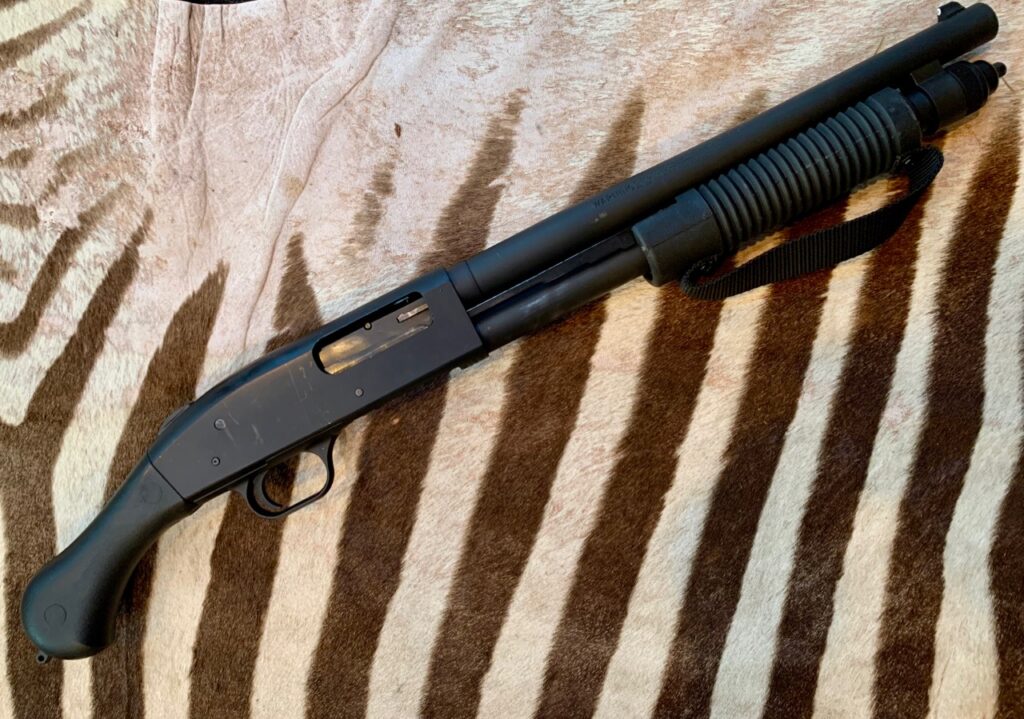
In 2017, Mossberg introduced the first mainstream version of the “Other” category of shotgun-like firearms in the United States. “Other” refers to this firearm’s classification under federal law. Due to the confusing and at times contradictory language of various laws, the smoothbore with whippet-type grip, 14” barrel and overall length greater than 26”, defies classification. It is merely an “Other”, as is a receiver or frame, and is transferrable from an FFL on nothing more than a standard BATF 4473 form and the usual NICS check.
Judging by local sales, the Mossberg 590 Shockwave has a been a runaway favorite. Its forbidden appearance mimicking a “sawed-off shotgun” certainly helps. Remington followed quickly with it’s own version, the Tac-14. Upon firing these guns, the general consensus has been “fun to shoot, otherwise totally impractical”.
I’ve fired both guns extensively and without training the general consensus has some merit. The recoil with standard 12 gauge loadings is substantial, and the untrained who attempt to aim the firearm using the bead in that circumstance, can often receive a bruised face, dropped firearm, missed target, or both.
“Lack of control with this firearm can be a serious safety issue”
Even experienced shooters have had the reaction of “thanks, had enough” after one magazine’s worth of shells. The firearm tends to recoil with torque at sharp angles, due to the unconventional stance required, and wants to separate from the shooters grasp. The Remington Tac-14 in particular is difficult to maintain a grip on with the provided Magpul forend, which works perfectly well on a shoulder fired Model 870, but doesn’t provide enough grip on the Tac-14. The Mossberg 590 Shockwave adds a forend strap, which is helpful in preventing the firearm from torquing out of the shooter’s support hand hold.
Lack of control of this firearm can be a serious safety issue. Fortunately it is manually operated and after the shot is fired, requires the shooter to maintain or regain control in order to load another shell into the chamber.
Firing off the hip produces the same kind of poor results as it does with any firearm, and especially so with a two-handed firearm due to lack of alignment between the firearm and the shooters arms. One can have a blast – literally – firing off the hip, but the accuracy results are inconsistent at best, and lack precision. If you don’t mind completely missing, or only getting part of the shotshell pattern on target – regardless of range – then you will find hip shooting more comfortable than attempting to fire from a sighted position.
While there probably are public skeet ranges that will allow these firearms to be used, I haven’t seen one. Using your own trap at informal ranges will allow you to have fun missing a lot of clay targets. Most users at public square ranges with target systems are restricted to slugs, to prevent damage to the system from wildly aimed buckshot. Five to ten full-powered slugs later, most shooters have had enough. Other potential shooting games are plinking at ground targets, walking the shot pattern into whatever the shooter is trying to hit. The latter pre-supposes a safe impact area of large size in all directions to contain ricocheting shot and slugs.
“Serious defensive use of the Shockwave requires planning and training”
In considering serious defensive use of the 590 Shockwave, the 5-shot magazine, compact dimensions, and 12 gauge chamber make it a potentially appealing source of handy close-range protection. However, employing it as such requires more planning and training than meets the eye.
Most purchasers assume the action will be very close, and firing off the hip will produce hits. This misinformed view is the result of lack of experience. At muzzle contact distance, hits might be obtained this way, but at anything past arms length (3 feet), all bets are off with hip shooting. During my career as a LE firearms instructor, I’ve watched numerous trained personnel completely miss targets as close as 10 feet while hip shooting and “point” shooting. This was on a square range, during training, qualification and combat courses. Under real stress, nearly all such type of shooting fails. The same reasons sighted firing is the current standard for LE firearms training applies equally to the Shockwave/Tac-14 firearms.
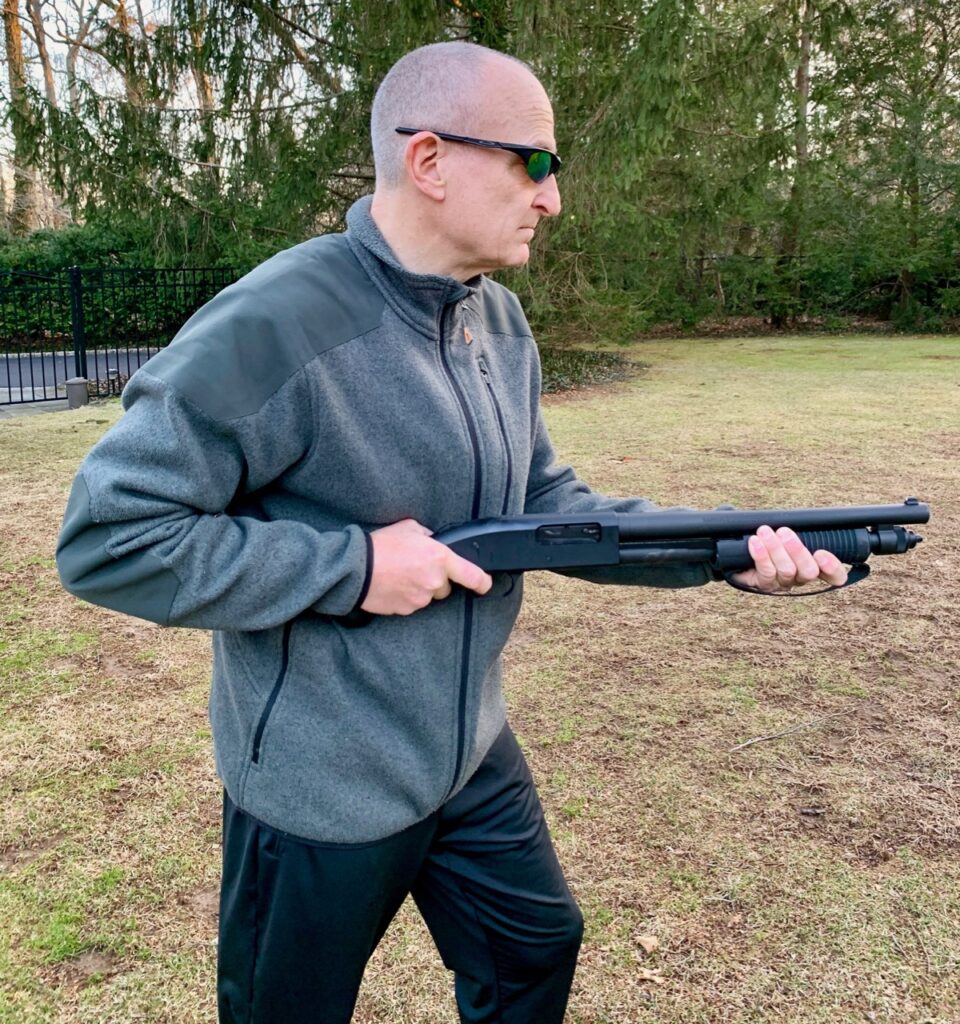
Most misses from non-sighted firing are the result of lack of consistent hand-eye coordination and misalignment of the firearm and the shooters body/arms/hands with the target. While these defects can be trained out on the square range, it takes many many hours of practice to do so. The end result is also far less consistent and accurate than if the same amount of time and resources had been devoted to sighted firing practice.
Moreover, once the reality of a confrontation takes over, targets do not remain stationary, and neither should you. The point/hip shooting system falls apart under stress. Only the most experienced shooters – who have done the majority of their training using sighted firing and have acquired substantial “muscle memory” with their particular firearm – can maintain some semblance of accuracy under stress with point/hip shooting, and only at close ranges.
No one can predict the distance a deadly encounter will take place, and limiting one’s options to 3 feet is unwise for many reasons. Nor is it a smart idea to discount the liability and tragic effects of missed projectiles flying downrange. For the Shockwave to be adequate, another way must be adopted.
SIX KEYS FOR THE DEFENSIVE SHOCKWAVE
FIRST, to make the Shockwave suitable for defensive use, is a simple effective sighting technique. Sighted firing techniques requiring extreme nuances and concentration and/or considerable physical strength in the arms are not practical in a sudden and stressful defensive situation for the average minimally-skilled shooter.
With a typical shotgun-style two-handed hold (pistol grip and forend), the firearm is raised quickly to a position with the arms extended, pushing towards the target. The front bead is brought into alignment with the dominant eye, along the top of the receiver sighting plane. The bead is superimposed in the center of the target. The weapon is fired. With practice, this can be attained quickly and consistently enough for defensive use.
“A simple effective sighting technique is the first requirement”
More sophisticated techniques include a push-pull action between the support and dominant hands, resulting in somewhat flexed arms and a reduction in recoil due to counterbalance of force. While effective, this technique is only useful for well-trained and experienced operators. Highly stylized techniques fail for the average shooter under stress, who tends to forget the fine points of technique, and reverts to “natural” movements and postures. Simple works better.
High Port Ready to Firing Sequence
SECOND requirement for the defensive Shockwave is sighting it in. With the recommended technique, accuracy is much improved, at least for the first critical shot. However, my personal Shockwave hit higher than point of aim at a short 21 feet with the small front bead provided. The awkward nature of gripping and sighting the weapon contributes to a high bead hold on target. The individual must test fire his own weapon in this regard.
To remedy the high point of impact, I installed a XS Sight Systems Big Dot Tritium Front Bead. The plain white version would work just as well. The higher bead forces a lower muzzle point on the target, and hence a lower point of impact. As an added benefit, the front bead is more more visible and faster for sighting. This bead is epoxied over the existing bead. Following the directions carefully, I have not had any durability issues with this bead, even after dropping the weapon.
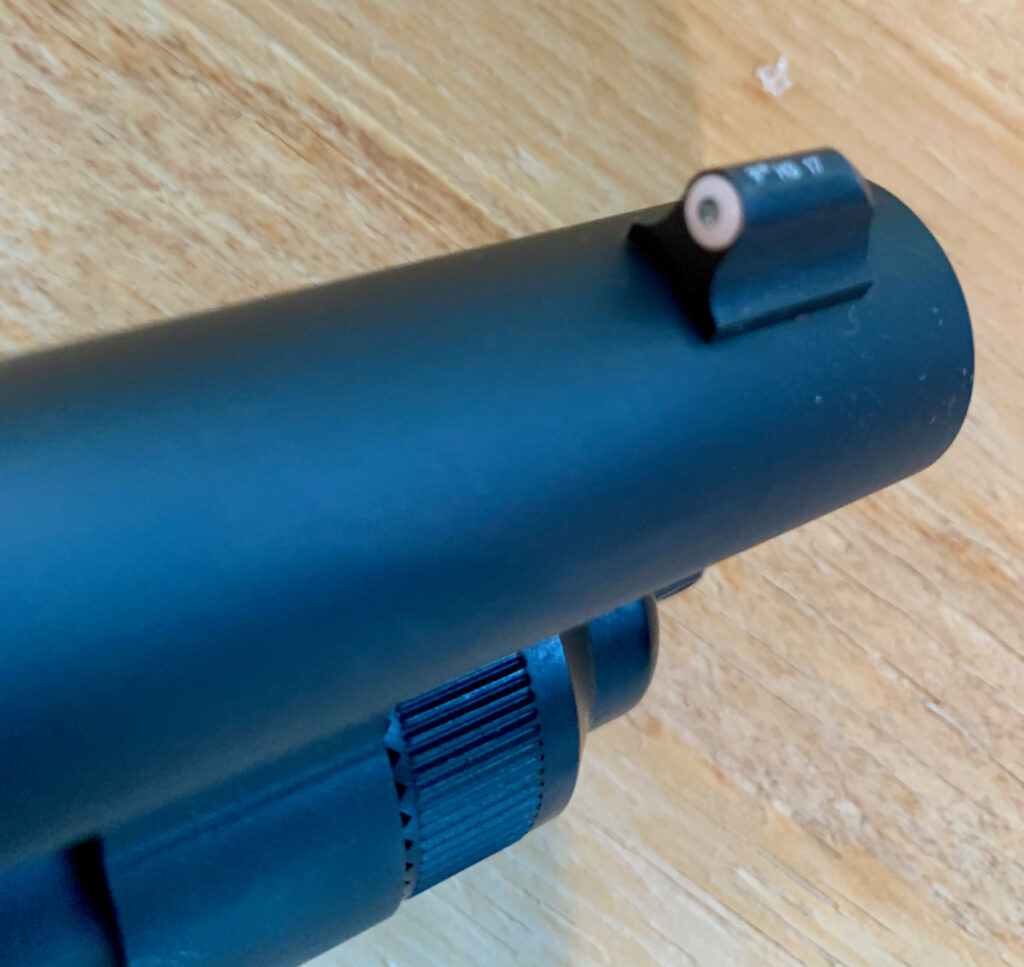
THIRD key for the defensive Shockwave is controllability and repeat fire. A single shot may not be effective in a given the situation, and the ability quickly and accurately fire multiple shots under control is necessary. As noted, recoil is high and controllability low with standard 12 gauge buckshot and slug loads. Especially using a simple firing technique, recoil must be minimized. There are two solutions to this problem:
- Reduced Recoil Ammunition. There are several varieties of these shells, and they offer significantly reduced recoil and greater control. For the distances the Shockwave is effective, they have plenty of power.
- Mossberg .410 Bore Shockwave. This small-frame version fires 2-3/4” and 3” .410 Bore shells, with substantially less recoil. Controllability is excellent. As a bonus, the lighter weapon is easier to handle for less physically conditioned persons. Several defensive .410 loads are available, including 00 and #4 Buckshot loads. Are they adequate? For the distance the Shockwave is employed, it would seem so. I suggest viewing the Paul Harrell video on .410 shotguns for defense, to be informed on the topic. Not as effective as 12 gauge, but still more effective than a sharp stick.

Note that the 20 gauge version of the Shockwave is not mentioned. Although 20 gauge shells fire a lower payload weight than 12 gauge, the 20 gauge version of the 590 Shockwave is built on a smaller lighter receiver. This reduced weapon weight negates the effect of the lower recoiling shell. Having fired both versions, the 20 gauge has no perceived recoil advantage over the 12 gauge with full loads in each. Moreover, there are no reduced recoil 20 gauge loads available. Reduced recoil loads in the 12 gauge Shockwave recoil less than the available 20 gauge buckshot loads in the 20 gauge Shockwave.
“For controllability and repeat fire, recoil must be minimized”
FOURTH consideration for the defensive Shockwave is realistic engagement range. The firearm is surprisingly accurate when using sighted fire, mechanically as good as the parent shotgun. The limiting factor is human capability, which in this case is due to the lack of shoulder stock, short sight radius and inherently awkward firing position. I have tested these weapons out to 25 yards, with no time limit on a benched position, and 12 gauge slug loads will easily group inside a 6 inch circle. But actually using the Shockwave at 25 yards under defensive conditions is difficult. Even 15 yards is stretching its practical capability for all but the most trained operators.
Moreover, why would you? A shoulder-fired weapon is far more appropriate for those distances. Considering that the Shockwave is not practical for concealed carry, the places you would have a Shockwave – your home or business – could easily contain a shoulder-fired weapon for distance shooting. The Shockwave is best reserved for close distances where it can be easily stored and employed – under a counter or bed, in a drawer, etc. You make compromises with this gun, and employment distance is one of them.
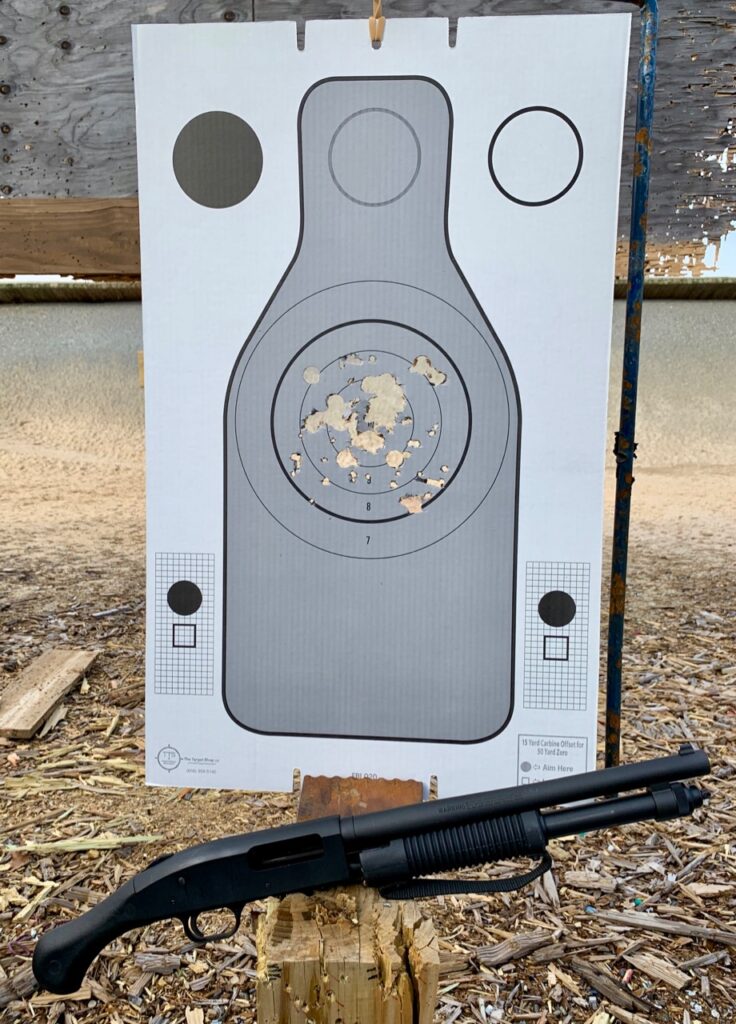
After my own testing, and observation of others, 10 yards is a realistic maximum effective range for trained shooters using sighted technique. For many users, 5 yards is a more realistic maximum. Greater maximum effective range is possible under rural conditions, where missed projectiles may be of less concern.
The lethal range remains the same as any 12 gauge shell – 200 yards and more. Respect must be given to the potential for buckshot and slugs to cause serious or fatal injury far beyond their effective defensive range. Shooter accuracy, and knowing what is behind/beyond the target is essential, as with any firearm. Not firing into a clearly unsafe direction must be stressed.
FIFTH aspect of the Shockwave in defense is ammunition. This is tied to reliability. Reliability of any defensive weapon is paramount, and the Shockwave and Tac-14 have proven to be just as reliable as their full-size shotgun parents… which is to say highly reliable.
Reduced Recoil 12 gauge 2-3/4” ammunition is often sold as “Tactical” or “Managed Recoil” loads. They feature some combination of reduced payload and speed: smaller amounts of buckshot (or a lighter slug) at lower muzzle velocity. Follow Newton’s Law and you have less recoil. And of course, less power. Is it enough power? Absolutely yes, for the uses intended at the distances intended. Moreover, these loads tend to pattern better than full power buckshot loads, especially the buffered “tactical” loads. Less errant pellets is a good thing.
Mini-shell 12 gauge ammunition is popular in these guns. While slightly shorter-than-normal length 12 gauge shells of European descent have been around for many years, they are of limited availability, and high cost. The new super-shorty shells are more reasonably priced, readily available, and specifically designed to give lower recoil, and higher magazine capacity. Aguila Mini-shell and Federal Shorty 1-3/4” shells increase the 590 Shockwave magazine capacity to 8. The Aguila buckshot version contains 7 #4 buckshot and 4 OO buckshot pellets, at a lower velocity. These shells are noticeably less powerful than even the reduced recoil 2-3/4” 12 gauge shells. Are they enough? At the distance the Shockwave is useful, certainly.
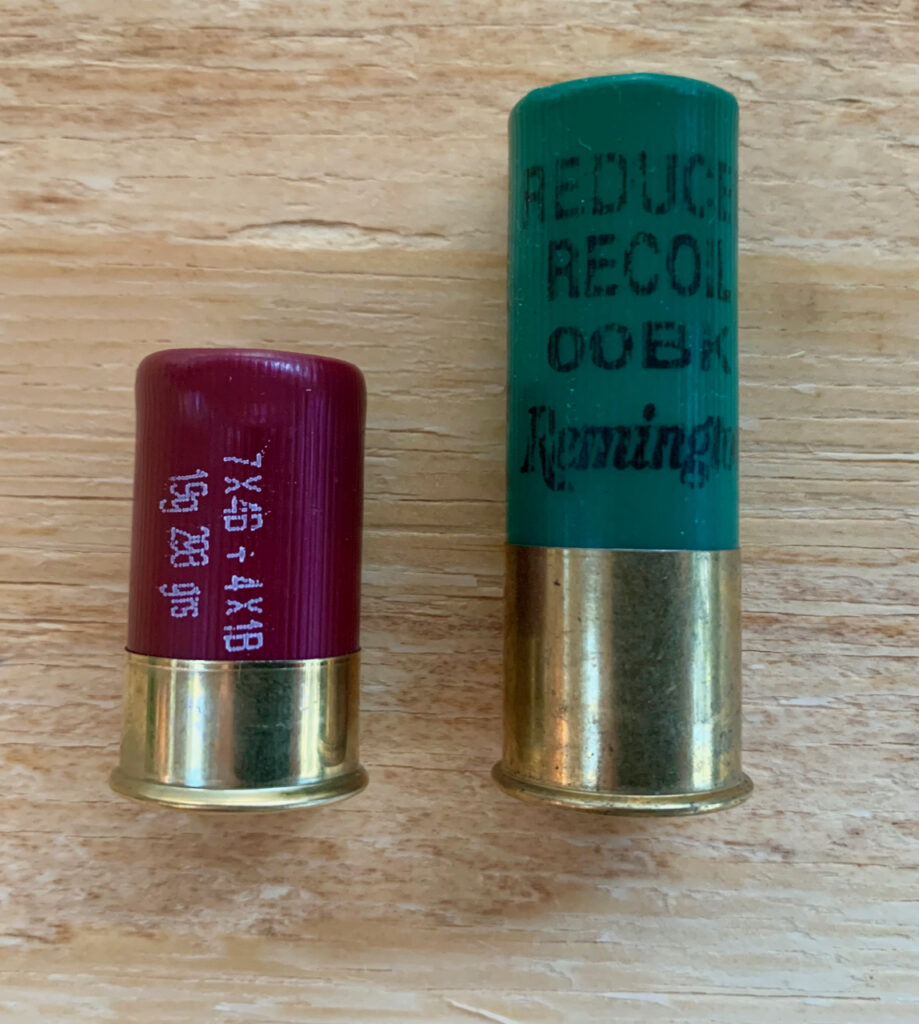
However, note that the Mini-shells will not function reliably in the 590 Shockwave without an aftermarket adapter. The Op Sol Minishell adapter is a drop in component that allows reliable feeding of the Aguila mini-shell buckshot loads from the Shockwave magazine. I cannot say the same for the Aquila mini-shell slug loads, which have not proven completely reliable even with the adapter. Note that regular 2-3/4” shells will NOT function with the Op Sol adapter installed. While the adapter is easily installed and removed, you must select a single loading for defensive use and stick with it.
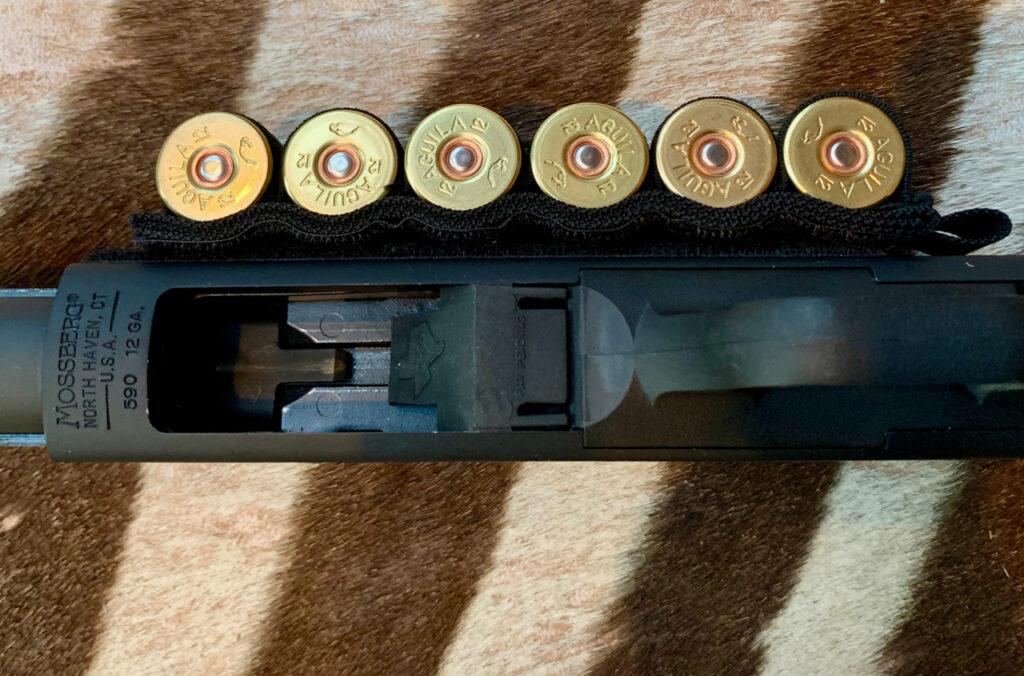
Which begs the question of which loads. Buckshot is possibly the best choice within the limited range of the Shockwave. When fired from the Cylinder bore Shockwave, buckshot groups – even with the worst patterning shells – are within the 12-15” width of a typical silhouette target at 10 yards. The multiple wounds created and large energy transfer, along with sufficient penetration, make it an idea load, especially indoors. At the close distance of 10 feet, most loads exhibit spread of less than 3 inches. The Federal Tactical OO Buckshot load with Flite Control Wad, will often pattern under 2” out to 10 yards.
Choice of buckshot size is individual preference. Within 10 yards there are no bad choices. Even buckshot can over penetrate depending on conditions, and I prefer less pellets over-penetrating. Either the Aguila Mini-Shell Buckshot load (with Op Sol adapter) or the Remington Reduced Recoil 8-pellet OO Buckshot load may be the best choices.
“Buckshot is possibly the best choice within the limited range of the Shockwave“
Most slugs are a poor choice in this weapon for defensive purposes. In 12 gauge, they grossly over-penetrate, regardless of power level. Given the 10 yard effective range of the Shockwave, the need for the extended range, accuracy and penetration is limited. Neither the practical accuracy nor employment indicate slug loads as the initial loading in the firearm. If used at all, slug loads should be reserved for spare ammunition, to penetrate cover if necessary or provide greater accuracy for shooting past 10 yards.
The SIXTH and final aspectis training. Complete familiarization with function, and firing testing must be undertaken. No firearm should be procured, loaded and stored without training, and the Shockwave doubly so, due to its unique requirements. Safe handling of this firearm requires strict adherence to safety and discipline.
The short length and two-armed operation can easily lead to inadvertent violations of the Cardinal Rules of Firearms Safety, including: unsafe muzzle direction, finger on the trigger when not on target, and failure to know the condition of the firearm (loaded or unloaded) at all times (chamber and magazine). Moreover, the short barrel length, if handled carelessly or sloppily, can lead to serious injury or death if the support hand gets in front of the muzzle due to lack of control of the firearm. The forend strap on the 590 Shockwave ensures the support hand is contained on the forend, well behind the muzzle. The strap serves an important dual purpose of control under recoil AND safe handling while firing. When practicing moving from ready to firing position, and reloading, strict downrange muzzle discipline is essential.
“Handling techniques should emphasize safe weapon control“
Whichever ammunition is selected for defensive use, the same should be used for training. Regular 2-3/4” buckshot loads can be supplemented with light target loads in 2-3/4” length for manipulation training. The lower dram equivalent loads with #7-1/2 shot are appropriate. The Aquila Mini-shells are available in both buckshot and birdshot loads. Mixing shell sizes is a bad idea.
The use of dummy shells are helpful in training. They should be brightly marked and used with caution, and no live ammunition should be present. A safe muzzle direction and containment backstop should be used when training with dummy shells.
Handling techniques should emphasize safe weapon control. Modification of traditional combat handling methods may be necessary due to the lack of a shoulder stock for support. Reloading technique is a good example of that. In the photos below, which technique offers more stability and control without a shoulder stock?
A receiver-mounted shell carrier will allow extra ammunition to be carried on the weapon. I prefer velcro-backed “shotgun cards” with elastic shell loops, mounted to a matching velcro on the receiver. They are lighter weight, less obtrusive, and easily removable when not desired.
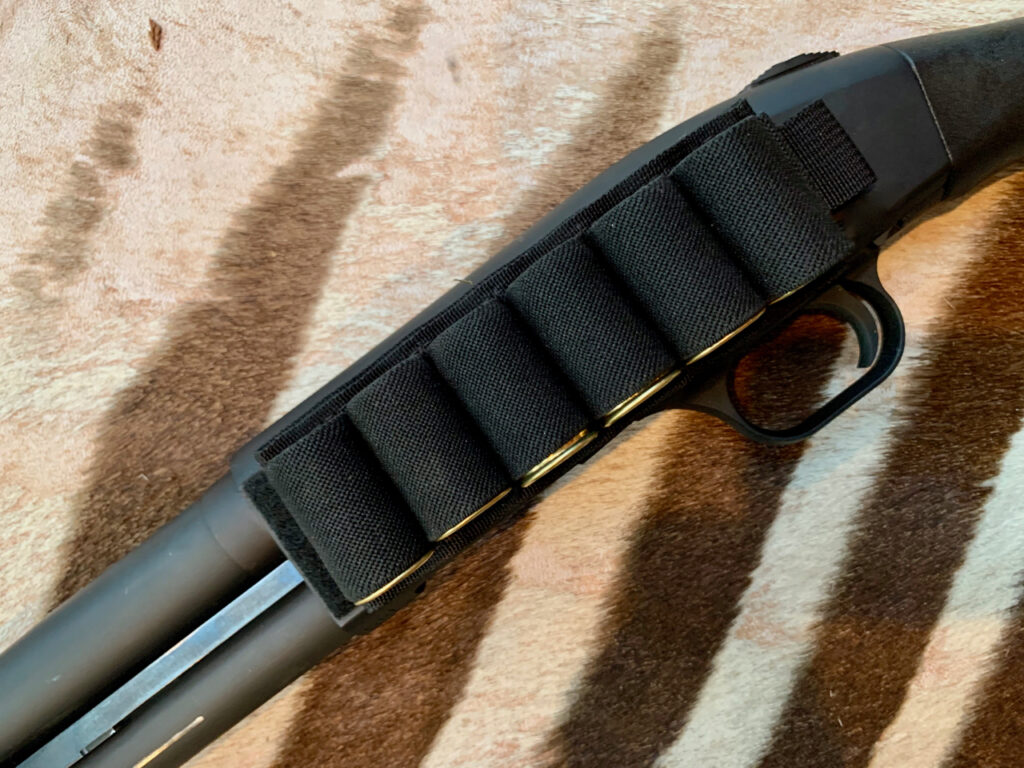
A safe ready position for the Shockwave is high port. Due to wrist flexibility and lack of a shoulder stock, low muzzle position with this weapon can easily lead to the shooter covering himself (feet, legs) or others with a loaded weapon. High port also allows the shooter to maintain a locked wrist position, essential for accuracy with the Shockwave, and easier access to the tang-mounted safety, which should be ON until the decision to fire is made.
Sample Shockwave Qualification Course of Fire
Target QIT. Ammunition 8 Buckshot, 6 Slugs. Scoring mini-shells 1 pt/pellet, 2 pts/slug. Scoring 8-pellet buckshot 1 pt/pellet, 6 pts/slug. Possible 100, Pass 80.
| Distance | Start Position | Sequence | TimeLimit |
| 3 Yards | High Port | Assembly Loaded. Fire 1 Buck. | 2 sec |
| 3 Yards | High Port | Fire 1 Buck with side step. Repeat. | 2 sec |
| 5 Yards | High Port | Fire 2 Buck. Reload 3 Buck if necessary. Repeat. | 3 sec |
| 5 Yards | Cover | Fire 1 Buck, Reload & Fire 1 Slug. | 8 sec |
| 7 Yards | Cover | Dryfire, Combat Load 5 Slugs, Fire 1 Slug. | 15 sec |
| 10 Yards | High Port | Fire 2 Slugs. Repeat drill. | 5 sec |
Shooting distance can be adjusted based on range constraints. Time limits can be adjusted dependent on skill level and distance. Note the use of slugs beyond 7 yards for this course. Pattern issues with individual shells occasionally result in pellet fliers, even with a well-aimed shot. Using slugs assists in evaluating shooter accuracy despite ammunition inconsistency. Slugs could be used for the entire course if buckshot is prohibited at the facility used.
The 590 Shockwave has the potential be a sound choice for close-range defensive use, especially if a handgun is not available. Yet it calls for some unique considerations and requires careful handling to be effective and safe.
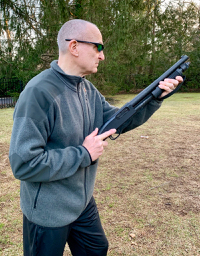
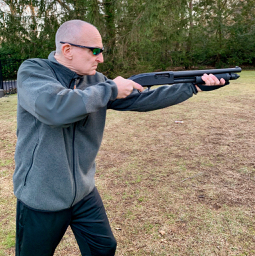
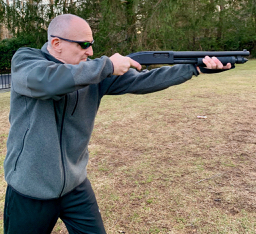
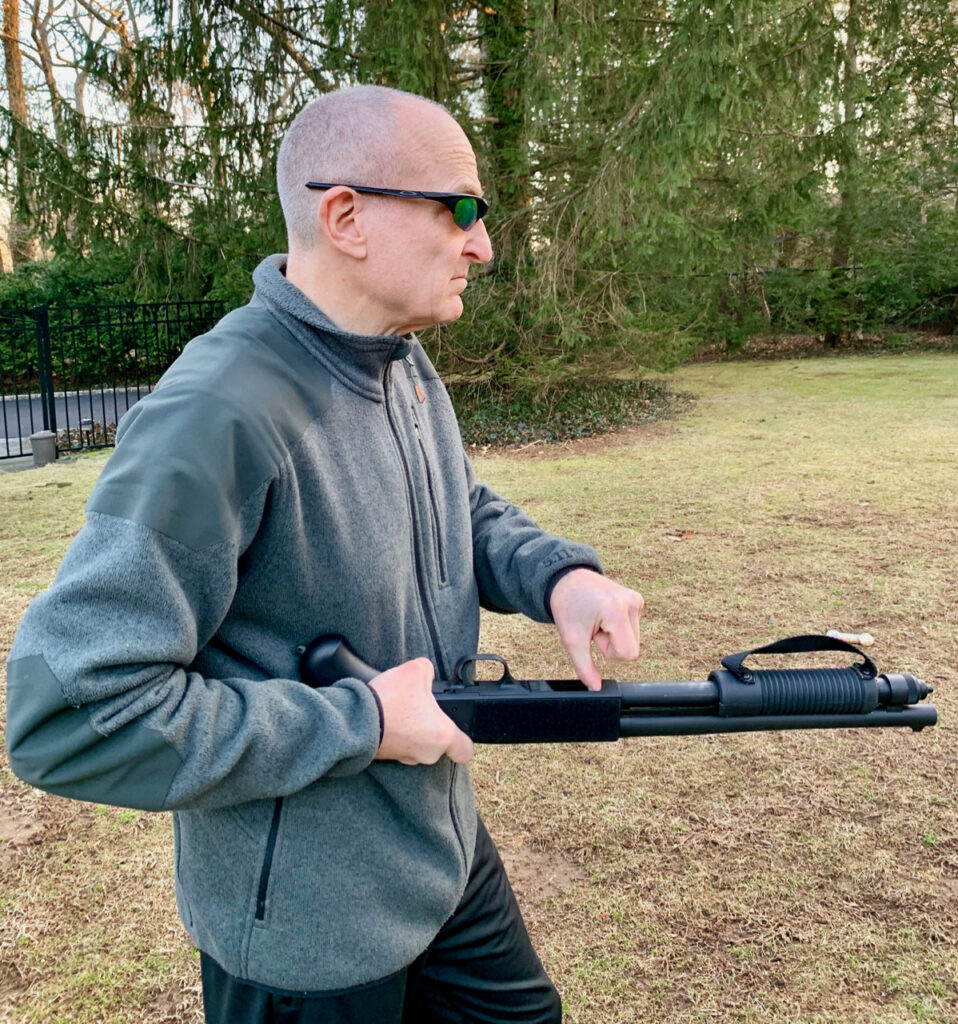
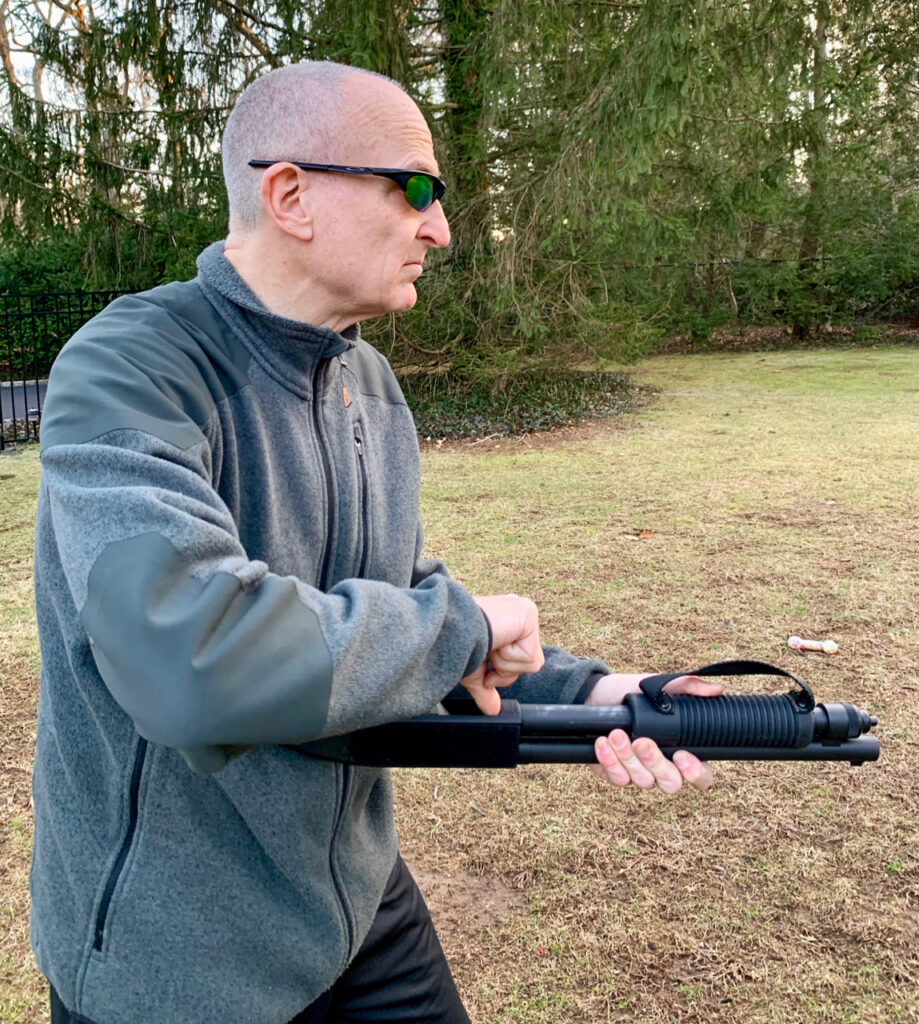
Very informative.